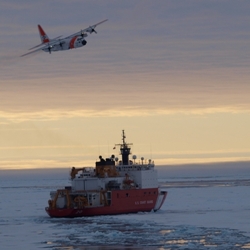
The Coast Guard charts a course for basic research before Arctic travelers find themselves on thin ice.
If regions were given hospitality rankings, the Arctic would fall somewhere between zero and below zero stars. Temperatures can plunge to −60°F, and winds can exceed 75 mph. Half the year, skies are black, making icebergs dangerous obstacles.
Still, the Arctic is critical to U.S. commercial and homeland security interests. In 2009, President Obama issued National Security Presidential Directive 66 / Homeland Security Presidential Directive 25, outlining the administration's Arctic Region Policy. The U.S. Coast Guard, a component of the Department of Homeland Security (DHS), plays a critical role in implementing this policy. Their mission includes securing international commerce, protecting the environment, defending America's maritime borders, and saving those in peril at sea or on other navigable waterways.
"In the near future, the Coast Guard will face challenges posed by increased commercial shipping, resource exploration, and recreational activity in that part of the world," says DHS program manager Theo Gemelas, who oversees two Centers of Excellence at the Department's Science and Technology Directorate (S&T). The Coast Guard's research planners are examining the future capability and technological needs of its operators. To ensure that tomorrow's Arctic guardians will get the tools they'll need, the Coast Guard must devise innovative solutions today.
Last fall, in collaboration with the U.S. Arctic Research Commission and the Coast Guard, DHS S&T hosted a 3-day workshop, "Operating in the Arctic: Supporting the U.S. Coast Guard Challenges through Research," at the University of Alaska at Fairbanks (UAF). The workshop brought together Coast Guard operational experts, academic researchers, Alaskan locals, scientists, and Canadian counterparts to define the research needs.
"Knowing what's in the water, on the water, and above the water will be critical to the Coast Guard's ability to execute its statutory missions. S&T is facilitating this important research," Gemelas said.
The workshop participants canvassed work already underway by the Department of the Interior, the Office of Naval Research, the Coast Guard Research & Development Center, the National Academies of Science and other organizations conducting research focused on the specific challenges. Three working groups focused on the following research areas:
Infrastructure: The distance between base sites in the Arctic can make it difficult to conduct rescue missions—the nearest operational base is 1,000 miles south, in Kodiak, Alaska—but building more bases presents its own challenges. Close-in sites may require large, heated hangars, which would likely call for rigorous design and construction criteria to guide architects, engineers, and builders, given the Arctic's inhospitable conditions. Until these criteria are met, the Coast Guard and its planes and helicopters will remain out in the cold.
Communication: When a distress call arrives, the Coast Guard must respond. But it can't respond to a call it can't hear, and the communications infrastructure in the Arctic region is limited. There are few radio repeaters—electronic devices that receive a signal and retransmit it, more powerfully, to extend its range. There also are no ship-to-shore cables or cell towers, nor sources to power them. So researchers are working to identify and develop communication systems appropriate for operators in this environment. If a distress call is heard, the nearest potential rescuer may be a local fisherman. In the future, the Coast Guard hopes to hear every distress call and contact the nearest ship in minutes—and even aims to monitor the rescue on a video screen.
Sensors: Sensors are critical to the Coast Guard's awareness of activities in the Arctic. Navigation, heat, sound, and other data from sensors placed in a variety of locations – on planes, ships and buoys and in space, at ground stations and on the sea floor – must be combined and sorted into a comprehensive, useable format in order to be helpful to Coast Guard operators. A network of sensors will help answer a potpourri of questions: How thick is this ice? How deep is that seafloor? Has oil spilled, and if so, how fast is it spreading and whither? Are aircraft wings or blades about to ice up? Where are the marine mammals? How many are there? Are they healthy?
In addition to a number of creative research ideas, the S&T workshop led to a funding opportunity announced in February 2011 by the DHS Center for Island, Maritime, and Extreme Environment Security (CIMES) at the University of Hawaii. "This research is an investment in the future of America's maritime security by people working at the cutting edge of science and technology applied to nationally relevant problems," says Gemelas.
And that's just the tip of the iceberg.
To request more information about this story, please e-mail st.snapshots@hq.dhs.gov.
